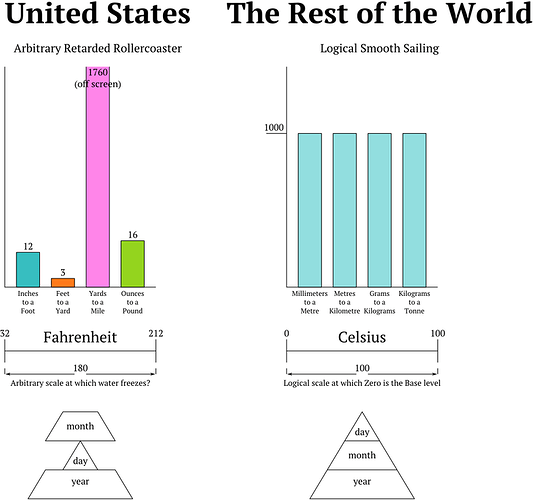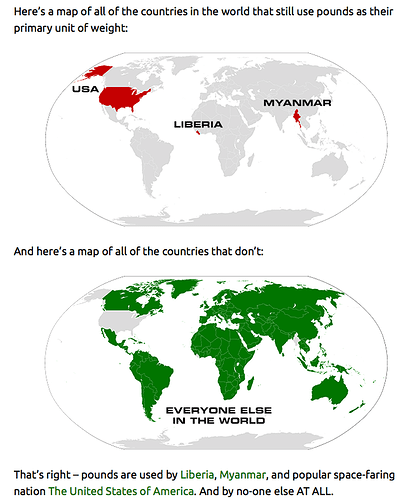The system is actually coded in metric and converted to imperial. It would be trivial for them to implement a software switch to show metric instead.
Ideally all cook books should give all ingredients as ratios of weight. Flour and other bulk goods settle or can be compacted. The only repeatable way to measure ingredients is ratios of weight. The base unit of weight you use is irrelevant as long as you stick with that unit. The problem your describing isn’t the fault of the units, it’s an antiquated use of the units.
You totally skipped over the fact that 1 cubic centimeter = 1 milliliter. If anyone unfamiliar with metric was reading that statement, they’d be lost at the hyphen. You’re taking for granted a conversion you “just know” and pointing that out as a flaw in other systems.
Since we are on the subject of liters. Why the heck even have them? All volume can be expressed in cubic linear units. If we are serious about making measurement systems better lets just do away with all volumetric specific units?
I’m going to go on a little a side here:
Honestly, liters have always bothered me. The typical way we step through volume in the metric system is
1 cm^3 = 1 mL, 1000 mL = 1L
the decimeter (dm) is a metric unit why don’t we do this
1 dm^3 = 1L
Traveling a bit further down this tangent, since the metric system was intended to be purpose built, why aren’t the base units of length, volume, and mass directly tied together?
1 m^3 = 1 L, 1 L of Water = 1 g
instead there is a powers of 10 roller coster
1 m = 100 cm, 1 cm^3 = 1 mL, 1000 mL = 1 L, 1 L of Water = 1 kg, 1 kg = 1000 g
Sub-tangent - Water. I love the stuff, but it’s got such a high rate of thermal expansion it’s should never have been used as a base unit of density. A cubic decimeter of water at 0 C, 20 C (not a clean base 10 number by the way), and 100 C all have drastically different weights. Fussed quarts is where it’s at. The stuff barely moves within the range of human tolerable temperature.
We now return you to your regularly scheduled rebuttal.
I doubt most people know the conversion ratio between Hectares and m^2 off the top of their heads even if it is a base ten ratio. If you don’t use a unit often switch between the units is always going to be cumbersome.
Easier - possibly - you still have to remember the correct direction to shift the decimal place.
More accurate - no. Accuracy is the ability to hit the center of the bulls eye. It doesn’t matter if its 1.420 miles away or 2.286 km.
When I was at primary school in the 1950’s, our teacher took us down to Crosby beach (near Liverpool, ) to measure out an acre using a chain (22yds.) To this day I can visualise the area of an acre. I have no idea of the area of a hectare or another area measurement which the media seem desperate to promote, the widely varying size of football pitch as a unit of measurement.
On entering the world of commerce after leaving school I worked as an accounts clerk for a shipping company. The conditions were quite Dickensian, big handwritten ledgers which had to be crossbalanced without the aid of an adding machine. No calculators in those days, so I became quite adept at adding up large columns of figures in my head.
Then came metrication, which started to be introduced into the building trade, then came decimalisation of the currency. There was a huge resistance to this as it was being debated in Parliament before the Act was passed. I thought that change was unnecessary at the time, but would not like to go back to what it was.
That said, I still have no idea of temperatures in Celsius. I know what 96 degrees F feels like, but am clueless when someone says "It was 26 degrees yesterday.)
I use a mixture of Imperial and Metric when measuring things. I make dolls’ houses and find metric measurements awkward for that, but inches are ideal for 1/12th, 1/24th and 1/48th scale houses.
Maybe we should have followed Sweden’s example in the 1960’s and changed the side of the road we drive on, but I fear that it’s now too late for that.
As I get older, the more entrenched are my views on a lot of things.
In this country, people under the age of fifty were not taught feet and inches or £.s.d, and in another fifty years no-one here will remember them.
We are all comfortable with what we’re used to. Few like change for change’s sake, but metrication started here in a small way and gradually expand over decades to reach the point it is at now. Could this be the answer?
By the way, one should sieve flour before use.
Almost every other country in the world managed it successfully. I cannot see how that famed ‘American Ingenuity’ would stumble over something even your military and scientific community is aligned to
Here’s what I don’t get… the resulting teaspoons are expressed as a decimal, not a fraction! Should be 7441 9/20!
Always apply all alliteration allowable. ![]()
Haven’t ever driven through middle America, have you? There are communities that think the 1950s were too progressive.
I think it’s more related to stubbornness than stumbling.
A little of both, I imagine. We apparently like to stumble due to our stubbornness all the time.
Metric will eventually get us because being only 5% or so of the world population and as the rest of the world’s per capita GDP catches up and/or passes us, there will be less and less willingness/necessity to cave to our stubbornness.
Personally, I’d prefer we just bite the bullet now rather than continue the fighting it.
Ha! touche!
I try very hard to avoid bringing up generalisations or politics on this forum, but i am very well aware of that mind-set both in the USA and Australia
Over here we have a saying that when you cross the border to Queensland (North Eastern State of Oz) you need to set your watch back 50 years.
In the hopper to make units user-switchable.
Also, for fastest response to feature requests, be sure to post in Problems & Support.
Looking at this explains why we (USA) can multiply and divide by 12, 3, 36, 16, 2… with aplomb but everyone else loses their collective minds with anything other than powers of 10.
But yeah, for close tolerance work I drop carpenter fractions and work in decimal inches or mm.
Hint, when guestimating a distance by eye, there is no difference between meters and yards.
If we ever go full metric I’ll never be able to have another yard sale. 
As a child of the 70’s I remember them trying to force the metric system on us. I use metric for all my engineering work, but almost anything with lumber is still imperial.
This graphic taken from
You will never see Microgamma the same way again!
Wow, never knew the rest of the world was so bass-akwards… #poundsforever

I was also given heavy metric emphasis in '70s science classes. I think we both benefited from it since we are fluent and comfortable with both systems. But I’d choose metric if given a choice.
So… Are we going to get a simple switch to metric?
I know of another US based company that sues a web-interface for their CNC machines - and THEY have got a simple switch. 
Peter
Yes it should a trivial change as all they have to do is draw metric rulers and change the material thickness and focus dialogues and add a configuration setting. As they haven’t done it by now I presume they never will because it is such a low hanging fruit.
Yah it’s right there at the same difficulty level with being able to save custom material settings.
It took one clever forum user a whole week, part time, to do that hack. For some reason the team of Glowforge developers haven’t been able to crack that one either.
I’m beginning to get annoyed with the lack of progress on the UI.


